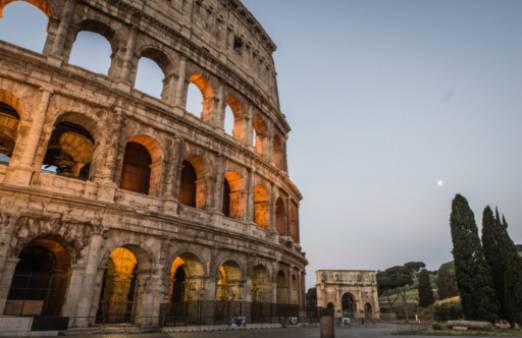The Catacombs of Rome hold a fascinating history of early Christianity, hidden beneath the ancient city streets. These underground burial sites have captivated visitors for centuries with their unique architectural features, symbolism, and early Christian burial practices. Today, preservation efforts and tourism allow visitors to step back in time and uncover the rich history of this important site.

Architectural Features of the Catacombs
The Catacombs of Rome are ancient underground burial sites that were primarily used by Early Christians in the first few centuries AD. These catacombs feature a unique architectural design that reflects the religious beliefs and practices of the time. The underground tunnels and chambers were carved out of soft volcanic rock and lined with burial niches where the deceased were interred. The passageways often featured intricate decorations such as frescoes, mosaics, and inscriptions that depicted biblical scenes and symbols of faith. The layout of the catacombs was organized into different levels and sections, with some areas reserved for specific Christian communities or martyrs. The design of the catacombs served both a functional and symbolic purpose, providing a sacred space for burial while also serving as a place of worship and commemoration for the early Christian community.
Symbolism and Iconography in the Catacombs
The Catacombs of Rome are not only a historical treasure trove of early Christian burials and practices, but also a rich source of symbolism and iconography. The walls of the catacombs are adorned with intricate frescoes and intricate mosaics that provide insights into the beliefs and practices of the early Christians.
One of the most common symbols found in the catacombs is the fish, which served as a secret symbol of Christianity in its early days when followers were persecuted. The fish, or ichthys, symbolizes Christ and his followers as "fishers of men." Other common symbols include the anchor, representing hope and salvation, and the shepherd carrying a lamb, symbolizing Christ as the Good Shepherd.
Iconography in the catacombs often depicts scenes from the Old and New Testaments, as well as images of martyrs and saints. These images served as reminders of the faith and courage of early Christians, as well as sources of inspiration and comfort for those visiting the tombs of their loved ones.
Overall, the symbolism and iconography found in the Catacombs of Rome provide a deeper understanding of the early Christian community and their beliefs, as well as a glimpse into the art and culture of the time.
Early Christian Burial Practices in the Catacombs
Early Christian burial practices in the Catacombs were a reflection of the beliefs and traditions of the early Christian community in Rome. The Catacombs served as underground burial grounds for Christians during a time when their religion was not widely accepted. Bodies were typically laid to rest in niches or small chambers in the walls of the Catacombs, a practice known as loculi. Some wealthier individuals had larger, more elaborate tombs known as cubicula.
In addition to the physical layout of the burials, there were also symbolic elements present in the Catacombs. Many of the tombs were adorned with Christian symbols such as the fish or the anchor, as well as scenes from the Old and New Testaments. These symbols served as both a way to identify the deceased as a follower of Christ and to provide comfort and hope to their loved ones.
The Catacombs were not only a place of burial, but also served as meeting places for the early Christian community. It was here that they would gather to celebrate Mass and commemorate the lives of those who had passed on. The Catacombs were a vital part of the early Christian experience in Rome, providing a sense of community and continuity in the face of persecution.
Today, the Catacombs of Rome stand as a testament to the early Christian faith and a fascinating glimpse into the history of Christianity in Rome.Visitors can explore these underground tombs, marvel at the intricate frescoes and inscriptions, and gain a deeper understanding of the beliefs and practices of early Christians in Rome.
Preservation Efforts and Tourism at the Catacombs
Preservation efforts and tourism at the Catacombs of Rome play a crucial role in maintaining these ancient underground burial sites and ensuring their accessibility to visitors from around the world. The catacombs are carefully managed and maintained by preservation organizations, with ongoing efforts to protect the delicate frescoes, sculptures, and other architectural features that offer insight into early Christian history.
These preservation efforts involve regular monitoring and conservation work to prevent deterioration and damage to the Catacombs' structures. Additionally, educational programs and initiatives are in place to raise awareness about the historical and cultural significance of the Catacombs, helping to promote sustainable tourism practices that respect and preserve these ancient sites for future generations to enjoy.
Tourism at the Catacombs provides an opportunity for visitors to explore the rich history of early Christianity and gain a deeper understanding of the religious practices and beliefs of the early Christians. Guided tours offer insights into the symbolism and iconography present in the Catacombs, allowing visitors to appreciate the artistry and craftsmanship of the ancient Christian artisans who created these intricate works.
By balancing the need for preservation with the demand for tourism, efforts are made to ensure that the Catacombs of Rome continue to be a fascinating and meaningful destination for travelers seeking a glimpse into the early Christian history of Rome. Through responsible management and conservation practices, these historic sites can be safeguarded for future generations to appreciate and learn from.
